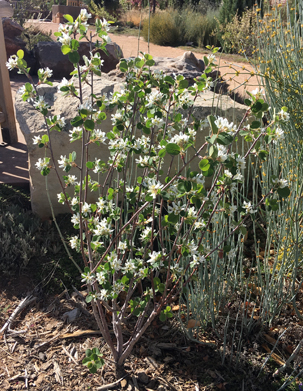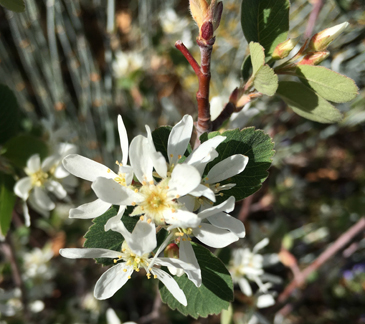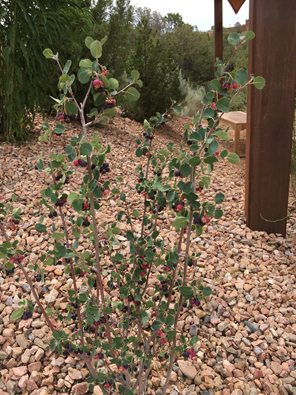 |
 |
The bush w/flowers |
The flowers |
 |
| Bush w/berries |
Description
"Amelanchier is native to temperate regions of the Northern Hemisphere, growing primarily in early successional habitats. It is most diverse taxonomically in North America, especially in the northeastern United States and adjacent southeastern Canada, and at least one species is native to every U.S. state except Hawaii and to every Canadian province and territory. Two species also occur in Asia, and one in Europe. The taxonomic classification of shadbushes has long perplexed botanists, horticulturalists, and others, as suggested by the range in number of species recognized in the genus, from 6 to 33, in two recent publications.[5][6] A major source of complexity comes from the occurrence of hybridization, polyploidy, and apomixis (asexual seed production), making speciesdifficult to characterize and identify.[7]
The various species of Amelanchier grow to 0.2–20 m tall; some are small trees, some are multistemmed, clump-forming shrubs, and yet others form extensive low shrubby patches (clones). The bark is gray or less often brown, and in tree species smooth or fissuring when older. The leaves are deciduous, cauline, alternate, simple, lanceolate to elliptic to orbiculate, 0.5–10 x 0.5–5.5 cm, thin to coriaceous, with surfaces above glabrous or densely tomentose at flowering, and glabrous or more or less hairy beneath at maturity. The inflorescencesare terminal, with 1–20 flowers, erect or drooping, either in clusters of one to four flowers, or in racemes with 4–20 flowers. The flowers have five white (rarely somewhat pink, yellow, or streaked with red), linear to orbiculate petals, 2.6–25 mm long, with the petals in one species (A. nantucketensis) often andropetalous (bearing apical microsporangia adaxially). The flowers appear in early spring, "when the shad run" according to North-American tradition (leading to names such as "shadbush"). The fruit is a berry-like pome, red to purple to nearly black at maturity, 5–15 mm diameter, insipid to delectably sweet, maturing in summer.[7]
Amelanchier plants are valued horticulturally, and their fruits are important to wildlife." (Wikipedia)
Ethnobotanical Uses
Food:
"Warning: The leaves and pits contain poisonous cyanide-like compounds. Cooking or drying destroys these toxins." (Kershaw 69)
"Abnaki Fruit Fruit used for food. --- Carrier Dried Food Berries dried for winter use." (Moerman 69)
"The flavor is not real strong, but is good mixed with other fruits in jams, pies, smoothies, fruit compote, fruit leather, dumplings and pemmican. May be dried for preservation." (Seebeck 81)
Medicine:
"Navajo Emetic Plant used as an emetic. Shoshoni Eye Medicine Decoction of inner bark, sometimes with roots, used as drops for snow-blindness." (Moerman 69)
"Saskatoon juice was taken to relieve stomach upset and was boiled to make ear drops. Green or dried berries were used to make eye drops, and root tea was taken to prevent miscarriage." (Kershaw 69)
Other Uses:
"Coeur d'Alene Tools Wood used to make root diggers. --- Shasta Hunting & Fishing Item Young shoots used to make arrows." (Moerman 69)
"These hard, strong, straight branches were a favorite material for making arrows, spears and pip stems. They were also used for canes, canoes (cross-pieces), basket rims, tipi stakes and tipi closure pins. The berry juice provided a purple dye."(Kershaw 69)